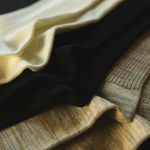Yes, ringspun cotton does shrink because its tightly twisted fibers contract when exposed to water and heat. To prevent this, you should wash your ringspun cotton clothes in cold water using a gentle cycle and avoid high heat when drying. Air drying or tumble drying on low helps minimize shrinkage. If shrinkage occurs, soothing the fibers and reshaping while damp can restore size. Keep going to discover more tips on caring for your ringspun cotton garments.
Table of Contents
Key Takeaways
- Ringspun cotton shrinks due to tightly twisted fibers contracting when exposed to water and heat during washing and drying.
- To prevent shrinkage, wash ringspun cotton in cold water on a gentle cycle and avoid high heat in drying.
- Air drying or tumble drying on low heat minimizes shrinkage and preserves fabric strength and softness.
- Managing shrinkage involves soaking damp garments in lukewarm water with conditioner, then gently stretching and air drying flat.
- Long-term care includes using mild detergents, avoiding bleach, storing folded, and ironing on low heat while slightly damp.
Understanding Ringspun Cotton Fabric
Although you might already be familiar with cotton fabrics, ringspun cotton offers a distinct texture and durability you should know about.
When cotton fibers are spun into ringspun yarn, they’re twisted more tightly than regular cotton. This process creates a softer, smoother fabric that feels more luxurious against your skin.
You’ll notice ringspun cotton is also stronger and more durable, making it ideal for everyday wear. Unlike standard cotton, which can feel rough or coarse, ringspun cotton holds its shape better and resists pilling.
This fabric’s quality makes it a popular choice for t-shirts, bedding, and other items you want to last longer while staying comfortable.
Understanding these qualities helps you appreciate why ringspun cotton stands out in the world of textiles.
Why Does Ringspun Cotton Shrink?
You’ll notice ringspun cotton shrinks because of its unique fiber structure, which contracts when exposed to water and heat.
The way manufacturers twist and finish the yarn also plays a role in how much the fabric tightens up.
Understanding these factors helps you manage shrinkage better.
Fiber Structure Impact
Because ringspun cotton fibers are twisted tightly together, they create a fabric that’s softer but also more prone to shrinkage when washed.
When you wash ringspun cotton, the fibers absorb water and swell. This swelling causes the tightly twisted fibers to relax and contract, leading to shrinkage.
Additionally, the fiber structure has more surface area exposed, which means water penetrates deeper and affects the fabric more thoroughly than looser weaves.
You’ll notice the fabric feels denser and smaller after drying because those compacted fibers pull closer together.
Understanding this fiber structure impact helps you handle ringspun cotton with care, like washing in cold water and air drying, to minimize shrinkage and maintain the garment’s fit and softness over time.
Manufacturing Process Effects
When manufacturers spin ringspun cotton, they apply intense twisting to strengthen the fibers, which also tightens the fabric structure. This process makes the fabric denser and more durable but can cause it to shrink once washed and exposed to heat.
As the fabric relaxes after manufacturing, those tightly wound fibers loosen slightly, leading to shrinkage. Additionally, the finishing treatments applied during production—like mercerizing or softening—can affect how much the fabric shrinks.
If you want to minimize shrinkage, look for ringspun cotton garments pre-shrunk by the manufacturer. Understanding that the manufacturing process inherently tightens the fabric helps you anticipate some shrinkage and take precautions, like washing in cold water and air drying, to maintain your garment’s fit and feel longer.
Factors That Influence Shrinkage in Ringspun Cotton
You’ll notice that how tightly the fabric is woven and its density play a big role in shrinkage.
The temperature you use when washing your ringspun cotton can also change how much it shrinks.
Plus, the way you dry your clothes has a strong impact on their final size.
Fabric Weave and Density
Although many factors affect how ringspun cotton shrinks, fabric weave and density play an essential role.
When you choose tightly woven ringspun cotton, the fibers are packed closer together, which limits how much they can contract during washing or drying. Conversely, looser weaves have more space between fibers, allowing greater shrinkage.
Similarly, fabric density impacts shrinkage; denser fabrics resist shrinkage better because their compact structure offers less room for fiber movement.
If you want your ringspun cotton garments to maintain their size, look for items labeled with tight weaves and higher thread counts.
Understanding these aspects helps you manage expectations and care for your clothing properly, reducing unwanted shrinkage and prolonging the fabric’s lifespan.
Washing Temperature Effects
Since temperature directly impacts fiber behavior, washing ringspun cotton in hotter water can cause the fibers to contract more, leading to increased shrinkage.
When you wash your ringspun cotton garments in warm or hot water, the heat causes the cotton fibers to tighten and pull together, reducing the fabric’s overall size.
To minimize this, you should opt for cold or lukewarm water settings, which help maintain the cotton’s original dimensions.
Additionally, avoid sudden temperature changes during washing, as they can stress the fibers and encourage shrinkage.
By controlling the water temperature, you also protect the fabric’s softness and longevity.
Drying Method Impact
When you choose how to dry your ringspun cotton garments, you directly affect their size and shape.
Using a high heat setting in the dryer can cause significant shrinkage, as the heat relaxes the cotton fibers, making them contract. To minimize shrinkage, opt for low heat or air-dry your clothes instead.
Air-drying is gentler and helps preserve the fabric’s integrity, reducing the risk of unwanted shrinking. Additionally, avoid over-drying; removing clothes while they’re slightly damp prevents excessive fiber tightening.
If you must use a dryer, consider using a delicate or tumble-dry low setting.
How to Properly Wash Ringspun Cotton
To keep your ringspun cotton garments in great shape, you need to wash them carefully.
Start by turning your clothes inside out to reduce friction and fading. Use cold water and a gentle cycle to prevent fibers from breaking down and shrinking.
Avoid harsh detergents; opt for mild, liquid detergents that preserve fabric softness. Don’t overload the washer—this guarantees your clothes have enough space to move freely and get properly cleaned.
Skip bleach and fabric softeners since they can weaken the cotton fibers. If you spot any stains, treat them gently before washing rather than using hot water to avoid setting the stain.
Following these steps aids in maintaining your ringspun cotton’s softness, fit, and durability over time.
Best Drying Practices for Ringspun Cotton
After washing your ringspun cotton garments carefully, how you dry them plays a big role in preserving their quality. Avoid high heat, which can cause shrinkage and damage fibers. Instead, air drying or using a low heat setting is best. If you use a dryer, remove items while slightly damp to reduce wrinkles and shrinkage.
| Drying Method | Heat Level | Impact on Ringspun Cotton |
|---|---|---|
| Air Drying | No heat | Minimal shrinkage, gentle |
| Tumble Dry Low | Low heat | Safe, slight shrinkage possible |
| Tumble Dry High | High heat | High shrinkage risk, fiber damage |
| Flat Drying | No heat | Maintains shape, no shrinkage |
| Hang Dry | No heat | Preserves fabric integrity |
Choose drying methods wisely to keep your ringspun cotton looking great.
Tips to Minimize Shrinkage When Caring for Ringspun Cotton
Although ringspun cotton is durable, you’ll need to take specific steps to minimize shrinkage and maintain its softness.
First, always wash your ringspun cotton garments in cold water; hot water causes fibers to contract, leading to shrinkage. Use a gentle cycle to reduce agitation, which can stress the fabric. Avoid bleach and harsh detergents, as they weaken fibers.
Wash ringspun cotton in cold water on a gentle cycle, avoiding bleach to preserve fabric strength.
When drying, opt for air drying or tumble dry on low heat to prevent excessive shrinking. If ironing is necessary, use a low heat setting.
Store your ringspun cotton clothes properly by folding them instead of hanging to avoid stretching.
Differences Between Ringspun and Regular Cotton Shrinkage
When you compare ringspun cotton to regular cotton, you’ll notice they shrink differently due to how their fibers are spun. Ringspun cotton is made by twisting and thinning the cotton fibers, creating a tighter, smoother yarn. This process results in a denser fabric that generally shrinks less than regular cotton, which uses thicker, loosely spun fibers.
Because regular cotton is less compact, it tends to shrink more noticeably after washing and drying.
You’ll also find that ringspun cotton maintains its shape better over time, while regular cotton might become misshapen or feel rougher post-shrinkage.
Understanding these differences helps you manage your clothes’ care better and pick the right fabric based on how much shrinkage you can tolerate.
What to Do if Your Ringspun Cotton Has Shrunk
If your ringspun cotton has shrunk, you can take steps to restore its size and shape.
Start by soaking the garment in lukewarm water mixed with a gentle fabric conditioner or baby shampoo for about 30 minutes. This relaxes the fibers, making them more pliable.
Soak your ringspun cotton in lukewarm water with gentle conditioner to relax and soften the fibers.
After soaking, gently stretch the fabric back to its original dimensions while it’s still damp. Lay the garment flat on a towel, reshaping it carefully, and let it air dry.
Avoid wringing or twisting, as this can cause further damage. If the shrinkage is minor, repeated gentle stretching after washing may help maintain size.
Long-Term Care Strategies for Ringspun Cotton Garments
To keep your ringspun cotton garments looking and feeling their best over time, you’ll want to adopt consistent care habits that protect the fabric’s integrity.
Always wash them in cold water using a gentle cycle to minimize stress on the fibers. Avoid harsh detergents or bleach, which can weaken the material.
When drying, opt for air drying or tumble dry on low heat to prevent shrinkage and fabric damage. Store your garments folded rather than hanging to avoid stretching out the fabric.
If you need to iron, use a low setting and press while the fabric is slightly damp.
Frequently Asked Questions
Is Ringspun Cotton Environmentally Friendly Compared to Regular Cotton?
Back in the day, you’d probably wonder if ringspun cotton’s greener than regular cotton. You’ll find it’s softer but uses similar resources, so it’s not a huge eco win unless it’s organic or sustainably produced.
Can Ringspun Cotton Cause Allergic Reactions or Skin Sensitivity?
You might experience skin sensitivity with ringspun cotton if you’re allergic to cotton fibers or chemicals used in processing. Always check labels and consider hypoallergenic options to avoid reactions and keep your skin comfortable.
How Does Ringspun Cotton Compare in Durability to Synthetic Fabrics?
Think of ringspun cotton as a sturdy oak tree—natural and breathable but not as tough as synthetic fabrics like polyester, which are like steel beams. You’ll find synthetics more durable, especially against wear and tear.
Are There Specific Brands Known for High-Quality Ringspun Cotton?
You’ll find brands like American Apparel, Everlane, and Uniqlo known for high-quality ringspun cotton. They focus on soft, durable fabrics that feel great and last longer, giving you excellent value for your money.
Does Ringspun Cotton Retain Color Better Than Regular Cotton After Washing?
You’ll find ringspun cotton generally retains color better than regular cotton after washing because its finer, smoother fibers absorb dye more evenly. Just wash in cold water and avoid harsh detergents to keep colors vibrant longer.
- Will 100% Cotton Percale Wrinkle? The Honest Truth - July 15, 2025
- Why Do Toenails Tear Percale Sheets and How to Prevent It - July 15, 2025
- Why Is Percale Considered a Superior Sheet? - July 15, 2025







